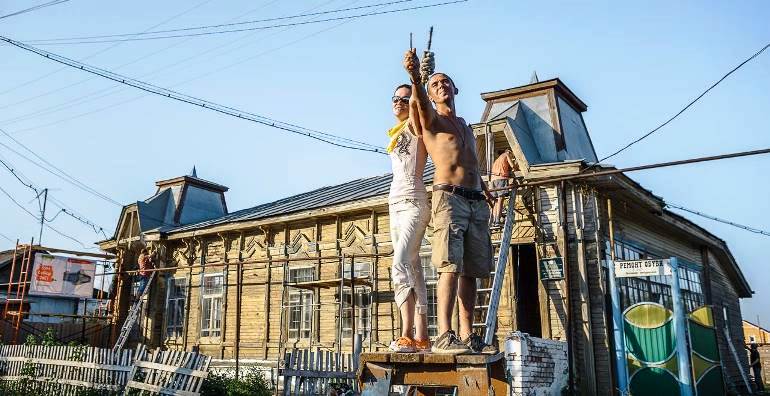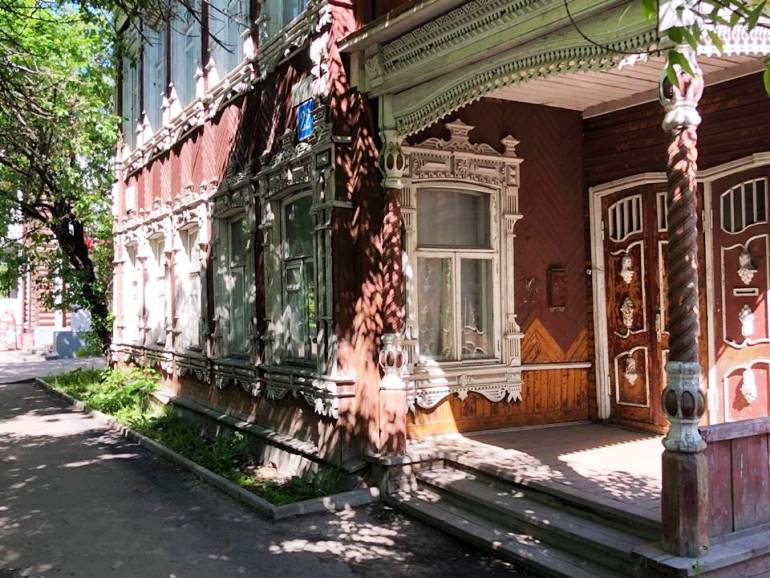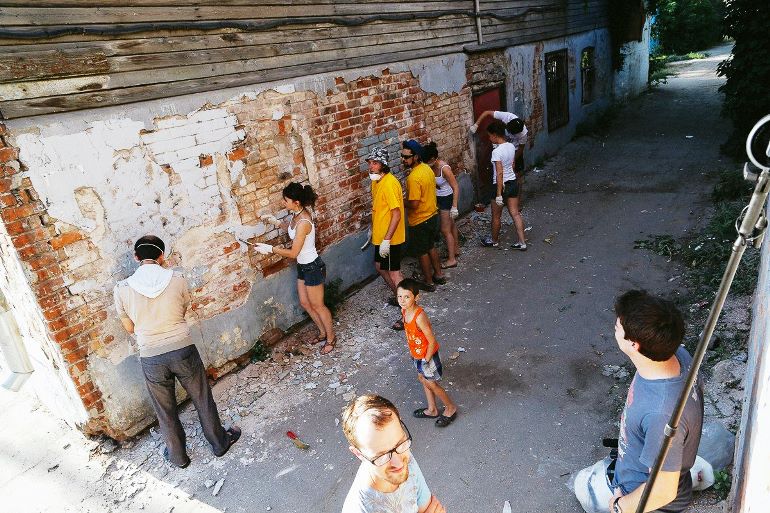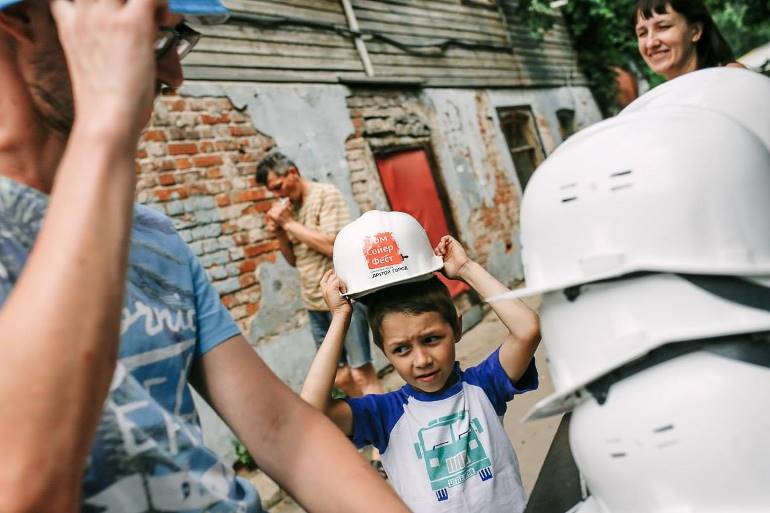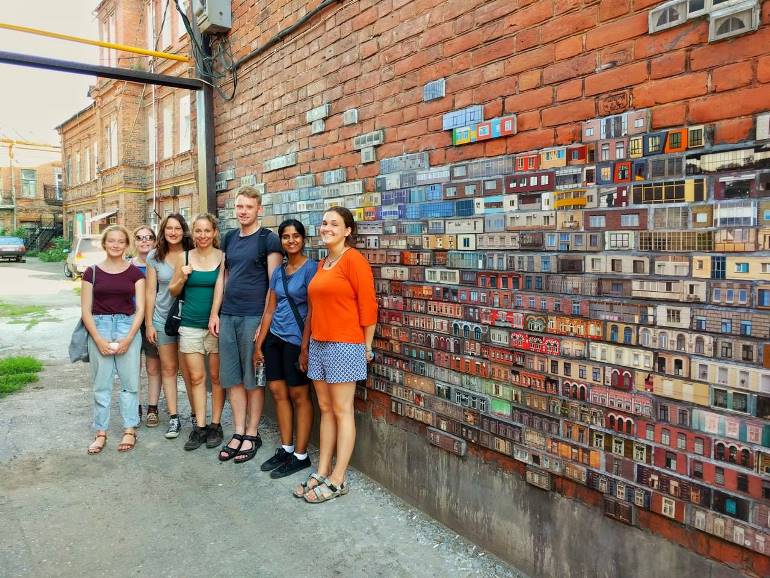Editorial office of Russkiy Mir Portal
Tom Sawyer Fest has been around for three years now, and last August it changed its status to the international one. Foreigners from France, Finland, Italy, Taiwan and Malaysia came to Russia to work on restoration of historic environment. “International name was of help,” believes Andrey Kochetkov, the festival’s mastermind, a historian, an urbanist, and a journalist.
Over the years of its existence, activists and engaged volunteers of Tom Sawyer Fest have spruced up more than sixty historic buildings in dozens of Russian cities and towns from Kaluga to Magnitogorsk. Tom Sawyer used to paint fences with a group of his keen friends, and the festival’s activists clean and stucco, replace doors and windows, repair roofs, all on his behalf. And at the same spot, amid scaffolds, they organize concerts, poetry readings, and have lunch with pirozhki* brought by residents of buildings being restored.
Photo credit: Tom Sawyer Fest / Facebook
The project started with spontaneous momentum of enthusiastic youth from Samara and turned into public movement with its own internal regulations, policies and schools. According to Andrey Kochenkov, despite extend of versatility and media presence of the festival, notorious word of mouth has proved to be the most viable mechanism of engaging volunteers and sponsors to restoration of historic environment in Russian cities and towns.
Festival school and word of mouth
- How would you summarize outcomes of the summer season? Do you differentiate “season” and “off-season” in your project?
- It is still early to talk about outcomes of summer: some works in some towns are still in progress. We do use such term as “season” and refer it to on-site works. But Tom Sawyer Fest keeps going all the year round. We look for new buildings, negotiate with sponsors and volunteers.
Photo credit: Tom Sawyer Fest / Facebook
- This year number of cities and towns, which joined the festival, has got two and a half times bigger. What do you account it for? And do you expect such trend to last?
- I account it for educational patterns that we implement. There were two trainings by Tom Sawyer Fest School in Samaraж this is where we pass on technologies to teams from new cities and towns. Word of mouth is also rather efficient – activists from different places communicate with one another, search for new practices. And when they see that at first Tom Sawyer Fest used to work in three cities, but then it has expanded to eleven, they wish to join the movement, and number of “daredevils” keeps growing.
- Is the project open for participation of historic cities only, or ancient age is not the exclusive pass to the Fest?
- We work with historic heritage; and the festival is focused on restoration of historic environment. Yes, areas and architecture of Stalin’s times may represent historic environment in some cities, but it is a different story. As you may understand, it is hard to handle a five-storey apartment block by efforts of volunteers. There are a lot of dangerous high-rise operations, which we do not allow. That’s the reason we mostly work on structures of up to two floors.
One comes with angle grinder, another one comes with camera
Photo credit: Tom Sawyer Fest / Facebook
- What is your response to skeptics who say – oh, what are they able to restore there with help of students? Volunteers are probably inspired, but they do not have any experience in restoration or construction works. Your activists actually do not suppress the fact that they lack knowledge and experience.
- I usually explain that our primary targets do not include popular cultural heritage sites, but valuable historic environmental development. However, I’d like to mention that many objects, which do not have any historic status, are not less significant than officially recognized monuments. It is our belief that they should stay where they are, accentuating essential gems of historic development.
Now let’s get to volunteers’ experience. Each and every team includes advisors, such as architects and restoration specialists. Needless to say, we welcome everybody, irrespective of experience. Tom Sawyer Fest takes place in those cities where facilitators have mastered assigning tasks based on likings and skills of every individual who comes and wishes to help. Someone likes and knows how to use an angle grinder, someone prefers brush, someone is busy with a camera in his/her hands, and someone else makes wonderful pastries. And each of the above is work.
Photo credit: Tom Sawyer Fest / Facebook
- How did the project begin? Which site was the first one?
- The first ones were three adjacent buildings on Leo Tolstoy Street in Samara. Decision to restore them was taken out of despair, because restoration of historic buildings in Samara was conducted at a very slow pace. Being journalists, we used to write a lot about this issue, but at some point we realized that things did not change and the initiative should be undertaken by us.
- What is inside the buildings which were the festival’s venues?
- Just the same as before the Fest. As a rule, we work on residential buildings with regular apartments within.
- How do residents respond to your involvement? Are there sometimes those who oppose restoration?
- Yes, sometimes there are. Over the past three years we have realized that we should take buildings under certain conditions: their residents wish to live in them, they understand their value and would like to help. It does not mean we will force 80 years old lady to work on scaffolds. There are many different ways to be involved. What matters is their willingness.
- Oftentimes, residents of wooden houses, understanding their historic value, want to move to a high-riser. Because they all the time experience roof leaking, windows freezing and etc. What spirits do you face?
- I wouldn’t say that all residents of wooden houses want to move out, not even majority of them. We look specifically for development venues and address buildings which residents maintain and wish to stay in. But they lack resources and skills to restore the building by themselves.
Behind the Tom Sawyer’s fence
- Do you communicate with foreign associates who preserve historic heritage in their own countries?
- At the first set-out we did not know that there was something alike in other places. This is why we did not adopt anything from anybody. Now we are aware of European and global trends in this area.
Last year I went to observe work of REMPART, a French association which is active on a quite large scale. It was interesting to learn more about it; however I noticed rather significant differences between their work and ours. In France volunteers restore some kind of neglected castles and other half-ruined structures; but our task is to support residents of historic buildings, bring them back understanding of how valuable their houses are.
Photo credit: Tom Sawyer Fest / Facebook
- Speaking of the name - Tom Sawyer Fest. I know there are those who criticize you for it. If we recall the story of a literary character, Tom Sawyer, and his fence, then my guess is that by using this name you suggest the following: if a good cause is properly wrapped up and presented, then people will be happy to work on it. Is it so?
- This episode from The Adventures of Tom Sawyer is the best known story about painting wooden surfaces in global culture. And it does its job, in particular for foreigners. This year volunteers from various countries came to our camp in Samara, and they worked at our sites. I believe it happened not least because of the Fest’s name. Everyone understands what it is about.
We plan to proceed with engagement of foreign volunteers in our projects since we have observed how effective it is, particularly for our cause, and for popularization of our historic heritage, especially wooden one. As it turned out, there are a lot of people who do not know anything about Russian unique wooden architecture. I hope that fame of this architecture will spread around the world, through Tom Sawyer Fest a well.
*Pirozhki - small Russian pastries filled with finely chopped meat, vegetables or fruit, baked or fried.

